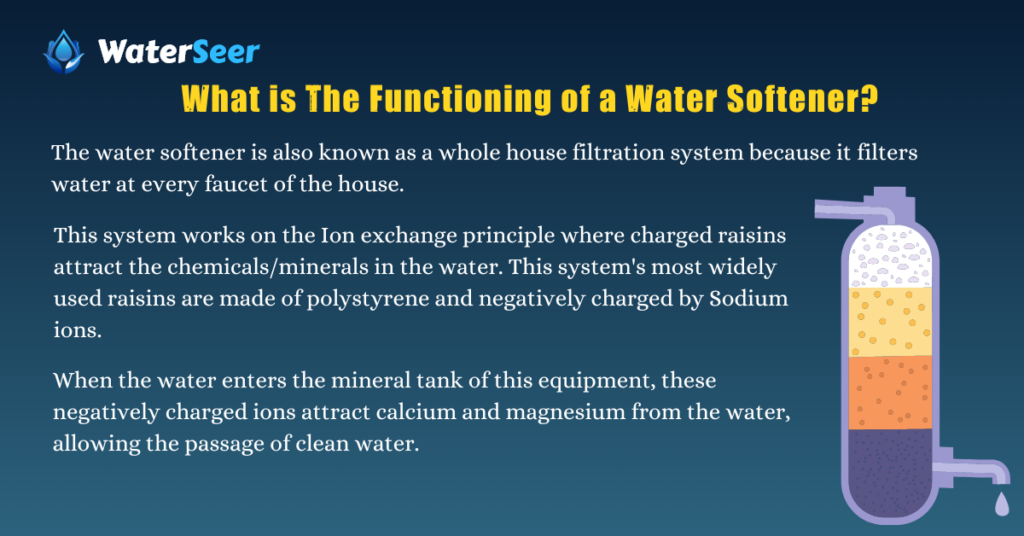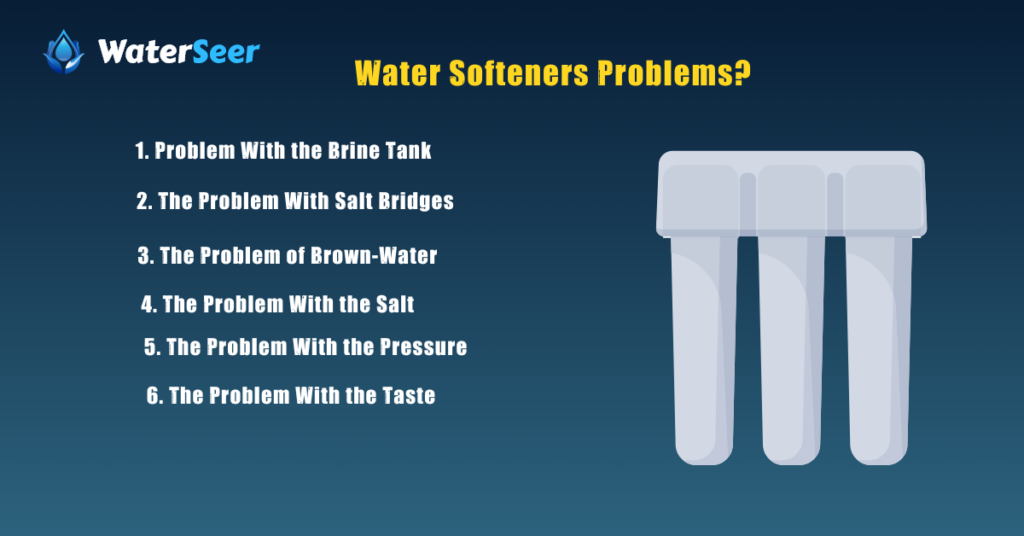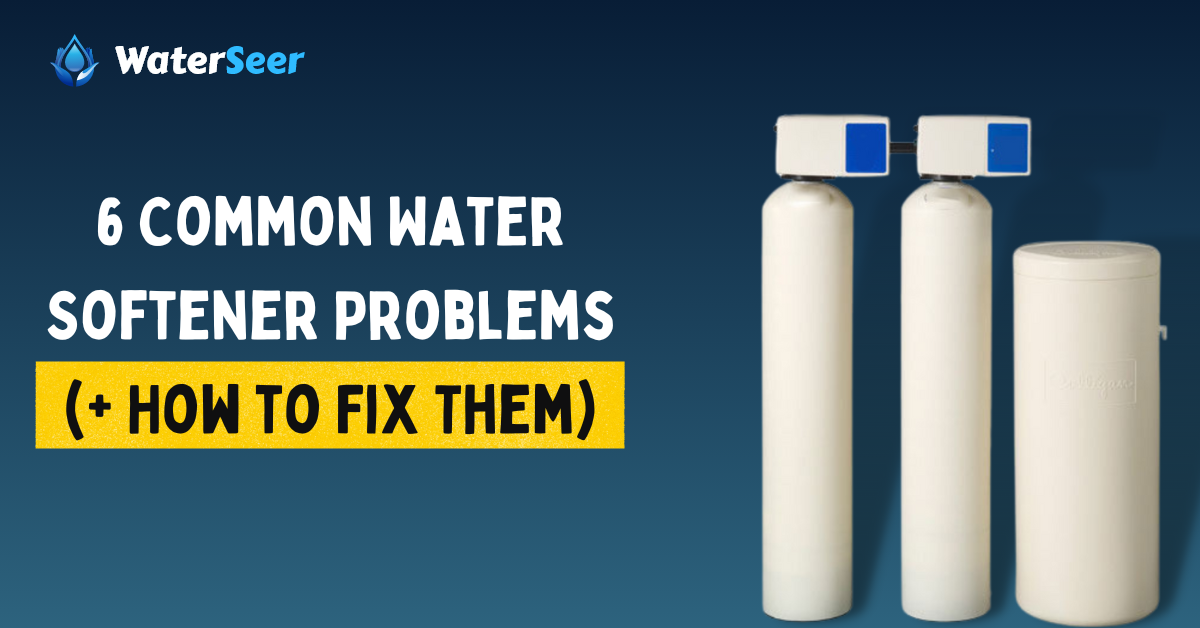Every appliance tends to malfunction sometime. The same thing happens with the water softener as well!
It is not a big issue if your water softener is malfunctioning. It’s just a machine that can malfunction sometimes. We got you covered!
This article will discuss the most common problems you may face with your water softener. In most cases, they are the most prevalent issues that create problems in the machine’s function.
Make sure you understand these problems and check your equipment correctly so you can figure out what exactly is going wrong and how you can solve it. If you have found the root cause, it will be easy for you to solve it.
Before discussing the problem, we should know what a water softener is and how it functions. The main reason behind this is that around 99% of the time, the main problem lies in its parts and functioning.
What is a Water Softener?
A water softener is equipment that removes all the minerals, like calcium and magnesium, responsible for causing the hardness of the water.
It has been reported that due to excessive industrialization and pollution, around 85% of all United States households use water softeners. This helps them filter and use the water for bathing, cooking, cleaning, and so forth.
A water softener is necessary in today’s world because it is effortless to use. In ancient times, most people used to rely on heating systems which not only took enormous energy, time, or money but also had a very high risk to the property or the house. The water software is one solution for all of these problems.
What is The Functioning of a Water Softener?

The water softener is also known as a whole house filtration system because it filters water at every faucet of the house.
This system works on the Ion exchange principle where charged raisins attract the chemicals/minerals in the water. This system’s most widely used raisins are made of polystyrene and negatively charged by Sodium ions.
When the water enters the mineral tank of this equipment, these negatively charged ions attract calcium and magnesium from the water, allowing the passage of clean water.
And this is how the minerals that make the water hard gets removed from the water.
The majority of water softener equipment comprises three essential parts. These parts are summarized below:
- The mineral tank consists of raisins, where the magnesium and calcium ions (in the water) get deposited.
- The control valve: This part controls the amount of water that is passing from the mineral tank.
- The brine tank: The primary function of this system or tank is in its regeneration which holds a high concentration of potassium or salt. The salt helps in restoring the positive charge of the raisin beads.
A wide variety of water softeners are available in the market, ranging from $600 to 1500 dollars. You can buy any of the water software available on the market; it entirely depends on your budget and the problems you face with water quality.
Whenever you visit the store, ensure that you have asked all your questions/doubts about the salespeople or employees.
It will give you good clarity on the maintenance/ replacement of the parts, electricity requirements, and cost.
Water Softeners Problems

In the above section, we have already talked about water softeners and how a water softener functions.
Now is the correct time to move forward and discuss the problems you can face with the water softener.
The following section will also discuss how you can solve the issues at home and how you can deal with them. We will look into the problems one by one:
1. Problem With the Brine Tank
In the above section, we have already discussed the different parts of water softener equipment. I am sure that you know what the brine tank is and its function.
The main problem with your water softener is the brine, which gets overflowed or clogged. The main reason behind this is that this tank consists of salt or a very high concentration of potassium, which can get you in trouble.
This problem happens when the equipment has become very old, and there are damages or cracks. The other reason can be if the water entry valve has been broken.
The pressure in the valve is very high. Thus, it releases excess water from the equipment. In such a situation, you need to replace the valve if it is broken or replace the brine tank completely.
Ensure you properly check the valve and the tank to avoid any issues afterward.
2. The Problem With Salt Bridges
Salt is a type of mineral ordinarily present in the water, so you can not prevent your pipes from getting scaled or affected.
As discussed earlier, a very high salt concentration can result in scaling the supply line or the tank as time passes. When excessive building up of salt occurs, it results in the formation of salt bridges, due to which the equipment cannot work correctly.
If you believe that this is the main problem, you can easily break or remove the salt bridge/crust. It is not a serious problem and won’t need expert assistance.
3. The Problem of Brown-Water
During the rainy seasons, we all have encountered the issue where the tap water is generally brown. But what if, even after installing equipment, the watercolor is brown, and it’s not even raining outside?
Here, the problem relies on your equipment. Whenever the brown water comes from the faucet, it means that it has a high amount of sediment in it. This can highly impact your day-to-day life, as it is not feasible to drink or cook.
Another factor that causes the brown water is the worn-out plumbing and higher accumulation of bacteria.
To solve this issue, you can simply use 2 cups of hydrogen peroxide or chlorine in the brine tank, then run the test or the regeneration cycle about three to four times. It will remove the hydrogen peroxide and chlorine and solve the issue of Brown Water.
4. The Problem With the Salt
We know that the third component of the equipment consists of a high concentration of salt, which helps in regaining the positive charges from the raisin beads.
If the salt level in the brink tank doesn’t change and stays the same, this indicates the salt is not being used. Therefore, no ion exchange halts the water-softening process of the hard water.
The brine tank in your water softener needs to be inspected frequently and cleaned as necessary. The water and salt in your tank become separated when salt bridges.
This prevents the tank’s bottom water from getting to the salt. Hard water results from the lack of salt since the salt will not dissolve to create a brine, which is necessary for a water softener’s raisin bed to regenerate.
This is the most common problem faced by water softener owners. In this situation, you must fix the salt bridges that developed over the brine tank’s water, causing improper regeneration. Contact the manufacturer or ask for professional advice.
The manufacturer will find a better solution or replace the entire kit or the tank.
5. The Problem With Raisin Beads
Another issue with the water software is that the raisin beads lose their effectiveness after a specific time.
Resin beads are utilized to boost efficiency. Usually, these beads survive as long as the system. The need for more regular salt replenishment arises because they can break or lose their potential in particular circumstances.
Even while this could be annoying, there is an easy fix. So, it becomes essential to replenish or replace the salt and raisins periodically. It will help maintain the equipment functioning; to do so; you should also clean or replace the parts.
Most of the time, this is a straightforward issue you can resolve without spending a fortune.
6. The Problem With the Taste
The water softener contains a high salt and potassium concentration. Have unclogged the equipment parts to reduce salt or potassium concentration.
This may result in stomachache and interfere with your digestive system.
7. The Silliest Mistakes
We are human beings, so we are prone to make errors, but sometimes the mistakes we make are silly, which can cause us a lot of trouble.
Electricity
Sometimes the problem is straightforward, but you cannot get it or find it on time. I am sure it may have happened to you sometimes as well.
Suppose you must have thought you had put your phone on the charger, but when you came back, you saw the switch was not on! That’s a silly mistake, right? I am sure it has happened to you as well.
The same happens with the equipment. This equipment runs on electricity so just recheck it once, whether it’s plugged in.
The Maintenance
Every piece of equipment needs regular maintenance, which will be written in its guidelines.
Every piece of equipment has a different maintenance period.
Whenever you buy equipment, make sure you have asked the salespeople or the worker about the type of replacement, maintenance, return, and so forth, because it will help you make a correct decision if something goes wrong with the machine.
There can be several reasons a machine cannot work; it is not always mandatory that it will be something mentioned above in this article.
Maintenance is essential for any engine to run correctly or function properly.
Suppose you are not doing periodic maintenance of the device. In that case, it will create problems, so ensure you protect your machines by maintaining them properly, allowing the water to flush down into the Machines, and checking the tubes periodically.
The improper functioning of the water softener not only results in the complete breakdown of the machine but also impacts your health because you will not get properly filtered water.
8. The Leaking
One of the most common problems in the water softener is leakage in any components. The leakage can be in the lines, tanks, or the other elements of the water softener.
Whenever you think there is a problem with the machine, ensure that you also identify the leakage problems. To do the same, check every part of the machine and inspect it properly if you have detected it.
If you cannot fix it, replace the component with another or the new one. It will help you to rectify the errors.
9. The Noises
Sometimes when the water softener does not function properly, it makes noises. This noise is not very loud, but you can notice something wrong with the machine.
The noise generally comes when a regeneration issue occurs in the equipment, and you can hear a running engine-like sound. It is usually caused by clogged valves, worn-out timers, or broken air valves.
10. The Operational Error
We all know that every machine runs with some manual settings. This is why most customers prefer to hire professional help or ask the manufacturer to replace the equipment.
This is also the right thing to do when you don’t have any machinery and technical knowledge about the equipment.
If you try to do it yourself, multiple things can go wrong, so it is always better to ask the professional to set up the unit and auto-install it properly.
The customer care center of the same manufacturer will always be ready to help you or assist you in whatever situation you are stuck in. So don’t hesitate and ask them.
A Pro Tip
If you have read all the points carefully, you will find the correct problem and know how it can be solved. But still, if you are confused about the equipment and cannot find the problem or root cause, then it is mandatory to call an expert.
If you cannot understand anything and just go to fixing, you would do much more wrong than better, so it’s better to leave it up to the professionals.
Frequently Asked Questions
What tools can be required to solve the water softener problems?
• Wrenches
• Shop vacuum
• Canned air
• Hose
• Syringe or turkey baster
• Paper clip or small wire
• Soapy water
• Small brush
• If you cannot identify the issue, we will always recommend hiring professional help or calling the customer care center of the manufacturer’s brand.
What are the most common causes of problems with the water softener?
Malfunction because of incorrect settings, no power, incorrect installment, clogged brine line, scale buildup, resin blockage, and so forth are all the most common issues that occur with a water softener afterward in the machine’s malfunctioning.
So we will always recommend you keep a check on the machine after a specific period.
Is it essential to disinfect the system?
Yes, it is essential to disinfect the system.
A water softener is equipment that removes minerals like calcium and magnesium from the water and provides soft water.
Every machine should be disinfected because it allows for drinkable water, which also has a high chance of building up disease-causing microorganisms that will directly impact your health.
Conclusion
The hardness of the water can create specific issues and impact an individual’s health, so it becomes essential to use the water softener.
Most of the time, the main problem relies on the functioning of the water softener, so it becomes essential for us to know how it functions. Once we identify the main issues, we can quickly solve the problem.
It is best to consult a professional on this if you are unsure about doing it on your own, and remember that your water softner is a machine that requires periodic maintenance and replacement of some components.
We hope that the above points mentioned in this article would have helped you to solve your issue.

